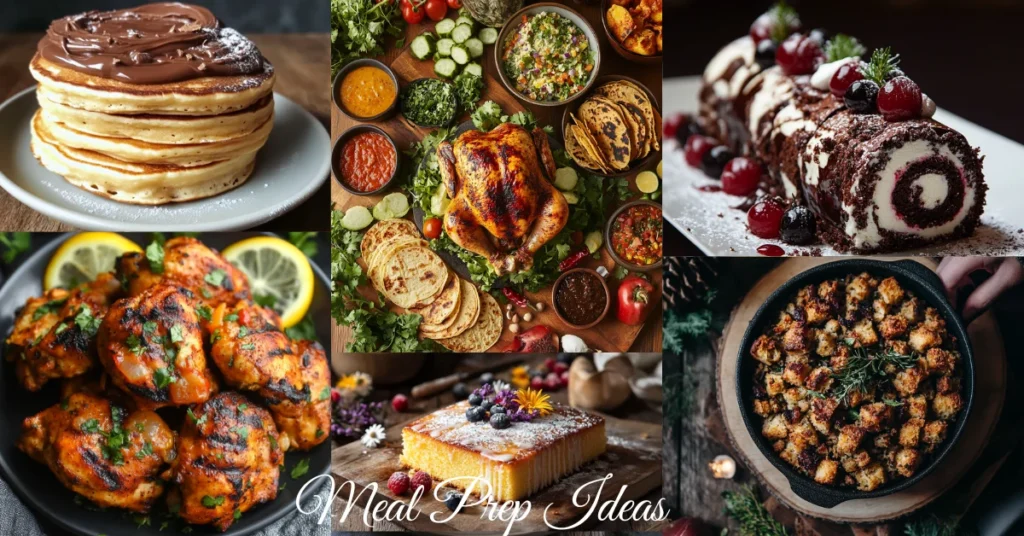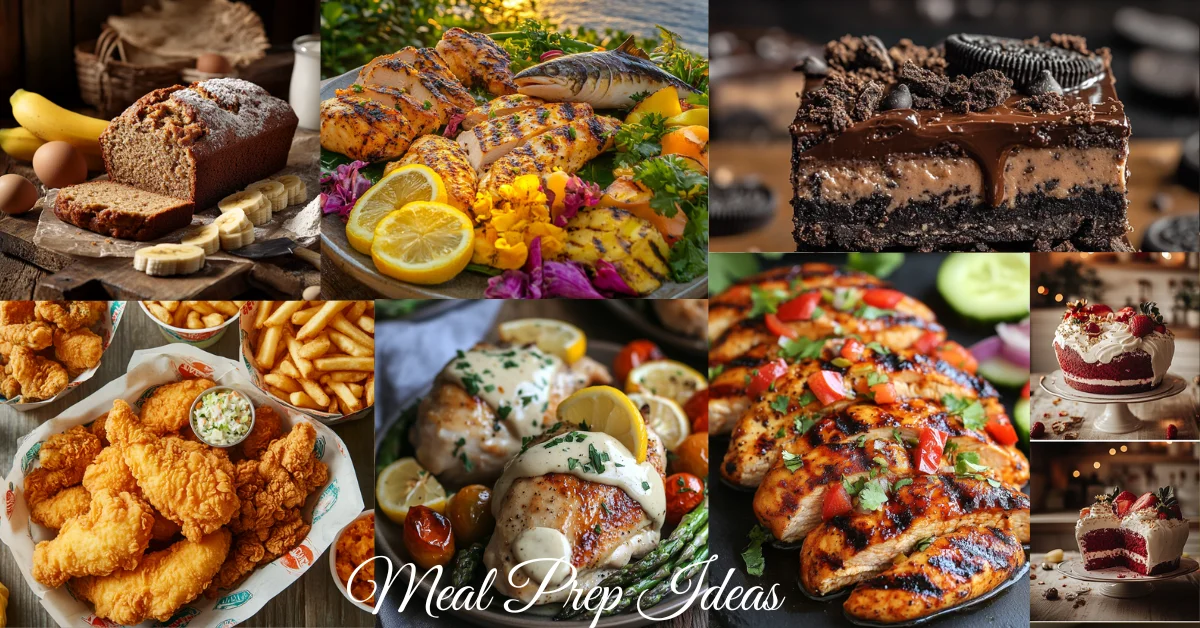Table of Contents of Meal Prep Ideas
- Introduction to Meal Prep Ideas
- Why Meal Prep is Essential
- Saves Time
- Encourages Healthy Eating
- Reduces Food Waste
- Saves Money
- Types of Meal Prep
- Batch Cooking
- Pre-Portioned Meals
- Ingredient Prep
- Freezer-Friendly Meals
- How to Plan Your Meal Prep
- Meal Prep Ideas for Different Diets
- Weight Loss
- Vegetarian
- Keto
- High-Protein
- Gluten-Free
- Breakfast, Lunch, Dinner, and Snack Prep Ideas
- Advanced Tips for Meal Prep Success
- Time-Saving Hacks
- Common Challenges and How to Overcome Them
- FAQs About Meal Prep
- Conclusion
Introduction to Meal Prep
Meal Prep Ideas have become an essential habit for anyone looking to save time, reduce stress, and prioritize healthy eating throughout their week. At its core, meal prep involves planning, cooking, and portioning meals ahead of time to ensure you always have something nutritious to eat.
For instance, how many times have you come home exhausted with no energy left to cook? Instead of reaching for unhealthy options like fast food or snacks, Meal Prep Ideas ensure that a healthy meal is always ready and waiting in your fridge. Furthermore, meal prepping reduces decision fatigue, allowing you to focus on more important tasks during your day.
Moreover, meal prepping is about more than just saving time—it’s a lifestyle change that fosters creativity in the kitchen. In fact, it encourages you to explore new recipes, experiment with ingredients, and even plan healthier meals for your family. Explore meal prep recipes here to get started.
Why Meal Prep is Essential
Meal prepping is not just for fitness enthusiasts or professional chefs—it’s for anyone who values convenience, health, and time efficiency. Here are several reasons why meal prep can transform your week:
1. Saves Time
Imagine dedicating just a few hours on Sunday to preparing meals for the entire week. Instead of cooking every single day, you’ll only need to reheat and serve. For example, batch-cooking a large pot of soup or chili means less time spent in the kitchen during the week.
In addition, meal prep eliminates the stress of deciding what to eat each day. By planning ahead, you can focus on other priorities, such as work, family, or fitness goals. Thus, it’s a practical way to maximize your time.
2. Encourages Healthy Eating
One of the biggest challenges to eating healthy is convenience. However, meal prep makes it easy to stick to your goals by ensuring you always have balanced, portion-controlled options readily available. Additionally, pre-portioned meals help you avoid the temptation of fast food or unhealthy snacks.
For example, if you’re aiming to eat more vegetables, prepping veggie-packed meals ahead of time ensures you always have nutritious options on hand. Similarly, you can plan high-protein meals to align with muscle-building or weight-loss goals.
3. Reduces Food Waste
According to the USDA, up to 40% of food in the U.S. is wasted annually. Meal prep significantly reduces food waste by encouraging you to buy only what you need. For instance, leftovers from dinner can be transformed into next-day lunches, reducing the chance of throwing away unused food.
In addition, meal prep teaches you how to use pantry staples more effectively. For example, cooked rice can be repurposed into stir-fries, grain bowls, or even stuffed peppers. As a result, you’ll save money while also helping the environment.
4. Saves Money
Did you know that cooking at home costs significantly less than ordering takeout? By prepping meals in advance, you can avoid costly last-minute takeout orders. Instead, you can focus on buying groceries in bulk, selecting affordable ingredients, and stretching meals further by repurposing leftovers.
For instance, a single roasted chicken can be used for multiple meals, such as salads, soups, or tacos. Therefore, meal prepping is an excellent way to stretch your budget while eating healthier.
Types of Meal Prep

There are several meal prep strategies, depending on your lifestyle and goals. Below, we explore the most popular types:
1. Batch Cooking
Batch cooking involves preparing large quantities of food and dividing it into portions for the week. This method is ideal for meals that store and reheat well, such as:
- Soups and Stews: Chicken noodle soup, lentil soup, or vegetable minestrone.
- Casseroles: Lasagna, baked ziti, or enchiladas.
- Curries: Coconut chicken curry, chickpea curry, or Thai green curry.
For example, try this Lemon Butter Garlic Shrimp Pasta as a batch-cooking option that works well for both lunch and dinner.
2. Pre-Portioned Meals
This method involves preparing individual meals in advance, so they’re ready to grab and eat whenever needed. It’s especially helpful for portion control and calorie management. Examples include:
- Protein Bowls: Quinoa, roasted veggies, and grilled chicken or tofu.
- Bento Boxes: Include a balanced mix of protein, carbs, and fresh vegetables.
Furthermore, pre-portioned meals save time during busy weekdays. Explore Mediterranean Quinoa Power Bowl recipes here for inspiration.
3. Ingredient Prep
Ingredient prep focuses on preparing individual components of meals rather than complete dishes. This approach is ideal for people who want flexibility in their meal choices throughout the week. Examples include:
- Roasting a batch of sweet potatoes to use in salads or grain bowls.
- Cooking chicken breasts or tofu to add to wraps, stir-fries, or salads.
- Pre-chopping vegetables for omelets, stir-fries, or salads.
By doing this, you’ll save time while keeping your meals varied and interesting.
4. Freezer-Friendly Meals
Freezer-friendly meals are perfect for long-term storage. By preparing these meals ahead of time, you can reheat them whenever needed without sacrificing flavor or quality. Examples include:
- Soups and chili
- Breakfast burritos
- Stuffed bell peppers
For instance, this Roasted Stuffed Bell Peppers recipe freezes beautifully and works well for busy weeknights.
How to Plan Your Meal Prep
Planning is the key to successful meal prep. Follow these steps to set yourself up for success:
- Set Your Goals: Are you meal prepping to save time, lose weight, or stick to a specific diet? Clarify your objectives before starting.
- Choose Recipes: Pick a variety of meals to prevent boredom. Additionally, look for recipes that share overlapping ingredients to save time and money.
- Make a Shopping List: Write down everything you’ll need for the week, and check your pantry first to avoid overbuying.
- Schedule Time: Dedicate a block of time on the weekend or your least busy day for meal prep.
- Invest in Storage Containers: Use BPA-free containers, mason jars, or freezer bags to keep your meals fresh and organized.
In addition, labeling your containers with the date and meal type ensures nothing goes to waste.
Conclusion
Meal Prep Ideas are a transformative habit that simplifies your life, saves you money, and ensures healthier eating. Whether you’re batch cooking soups, assembling grab-and-go lunches, or freezing meals for later, planning ahead makes all the difference. Recipes like the Mediterranean Quinoa Power Bowl and Roasted Stuffed Bell Peppers are perfect starting points for beginners looking for practical and delicious options.
Ultimately, with consistent practice, meal prep becomes second nature—and your future self will thank you!

